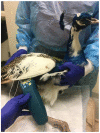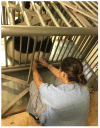Acupuncture and Traditional Chinese Veterinary Medicine in Zoological and Exotic Animal Medicine: A Review and Introduction of Methods
- PMID: 35202327
- PMCID: PMC8877432
- DOI: 10.3390/vetsci9020074
Acupuncture and Traditional Chinese Veterinary Medicine in Zoological and Exotic Animal Medicine: A Review and Introduction of Methods
Abstract
Acupuncture has been used extensively in domestic animal medicine to treat a variety of medical conditions and diseases as an adjunct or primary therapy. Exotic animals are becoming increasingly common as pets. Owners are expecting therapies for these non-domestic animals to be similar to those available to their other domestic pets. Additionally, zoological and aquatic facilities provide medical care for the entire lives of the animals that are housed in their facilities. Many conditions similar to those observed in domestic animals can develop in zoological species and can benefit from treatment with acupuncture. Through operant conditioning or routine medical examinations, the use of acupuncture as an adjunct therapy is becoming more common. The following paper presents a summary of the types of non-domestic animals treated, for which conditions, and how these methods are commonly used.
Keywords: acupuncture; aquapuncture; electroacupuncture; exotic animal; non-domestic animal; zoo animal.
Conflict of interest statement
The authors declare no conflict of interest.
Figures











References
-
- Yu C., editor. Traditional Chinese Veterinary Medicine. China Agriculture Press; Beijing, China: 1985. pp. 1–6.
-
- Xie H. Equine Aupuncture: From Ancient Art to Modern Validation. Am. J. Trad. Chin. Vet. Med. 2009;4:1–4.
-
- Xie H.S. How to Use Acupuncture for Elephants. Eastern States Veterinary Association; Gainesville, FL, USA: 2004. pp. 1457–1458.
-
- Ren Y.M., Xu Z., Zhang L.Q., LÖ F.Y., Yu B.J., Zhang Z.D., Gong S.Y., Xia M.S., Yang Z.R. [Location, Selection, and Comparative Anatomy of “Taixi” (Ki3), “Shuiquan” (Ki5), “Fuliu” (Ki7), “Jiaoxin” (Ki8), “Zhubin” (Ki9), and “Yingu”(Ki10) Acupoints in Rabbits] Zhen Ci Yan Jiu. 2020;45:929–935. - PubMed
Publication types
LinkOut - more resources
Full Text Sources

